Mazda B-Series (North America)
| Ford Ranger | |
|---|---|
 |
|
| Overview | |
| Manufacturer | Ford |
| Production | 1982–2011 |
| Model years | 1983–2011 |
| Body and chassis | |
| Class | Compact pickup truck |
| Layout | Front-engine, rear- / four-wheel drive |
| Chronology | |
| Predecessor | Ford Courier |
| Successor |
Ford F-150 Ford Ranger |
| First generation | |
|---|---|
 |
|
| Overview | |
| Production | January 1982 – 1988 |
| Model years | 1983–1988 |
| Assembly |
Louisville, Kentucky, United States St. Paul, Minnesota, United States |
| Powertrain | |
| Engine |
V6 engines
Diesel engines
|
| Transmission |
Manual transmissions
|
| Dimensions | |
| Wheelbase | 107.9 in (2,741 mm) 113.9 in (2,893 mm) 125 in (3,175.0 mm) |
| Length |
Standard bed 1983–1988:175.6 in (4,460 mm) 1989–1992:176.5 in (4,483 mm) Long bed 1983–1988:187.6 in (4,765 mm) 1989–1992:188.5 in (4,788 mm) Supercab 1983–1988:192.7 in (4,895 mm) 1989–1992:193.6 in (4,917 mm) |
| Width | 1983–1988: 66.9 in (1,699 mm) 1989–1992: 66.8 in (1,697 mm) |
| 1993–1997 | |
|---|---|
 |
|
| Overview | |
| Also called | Mazda B-Series |
| Production | August 1992 – July 1997 |
| Model years | 1993–1997 |
| Assembly |
Louisville, Kentucky, United States St. Paul, Minnesota, United States Edison, New Jersey, United States General Pacheco, Argentina |
| Body and chassis | |
| Body style | 2-door compact 2-door extended |
| Powertrain | |
| Engine | 2.3 L OHC I4 3.0 L Vulcan V6 4.0 L Cologne V6 |
| Transmission |
Manual 5-speed Mazda M5OD-R1 Automatic 4-speed A4LD 4-speed 4R44E 4-speed 4R55E 5-speed 5R55E |
| Dimensions | |
| Wheelbase | 107.9 in (2,741 mm) 113.9 in (2,893 mm) 125.2 in (3,180 mm) |
| Length | 184.3 in (4,681 mm) 196.3 in (4,986 mm) 198.2 in (5,034 mm) |
| Width | 69.4 in (1,763 mm) |
| 1998–2012 | |
|---|---|
 |
|
| Overview | |
| Also called | Mazda B-Series |
| Production | August 1997 – December 16, 2011 |
| Model years | 1998–2012 |
| Assembly |
St. Paul, Minnesota, United States Edison, New Jersey, United States General Pacheco, Argentina |
| Body and chassis | |
| Body style | 2-door compact 2-door extended (1998–2011) 2+2-door extended (1999–2011) 4-door crew cab (South America) |
| Powertrain | |
| Engine | |
| Transmission |
Manual 5-speed Mazda M5OD-R1 Automatic 4-speed 4R44E 5-speed 5R55E |
| Dimensions | |
| Wheelbase | 111.6 in (2,835 mm) 117.6 in (2,987 mm) 125.9 in (3,198 mm) |
| Length | 188.5 in (4,788 mm) 200.5 in (5,093 mm) 202.9 in (5,154 mm) |
| Width | 70.3 in (1,786 mm) |
| Height | 68.3 in (1,735 mm) 69.4 in (1,763 mm) |
The Ford Ranger is a compact pickup truck that was manufactured and marketed by Ford Motor Company from 1983 to 2012 model years for North America; from 1997 to 2011, a version was also manufactured and sold in South America. Introduced to replace the Ford Courier produced in Japan by Mazda, the Ranger was produced in two distinct generations. While introduced a year after the Chevrolet S-10, the Ranger would go on to become the best-selling compact truck in the United States from 1987 to 2004.
Over its production life, the chassis and underpinnings of the Ranger would be used for various compact Ford trucks, most commonly as sport-utility vehicles. During the 1990s and 2000s, Mazda adopted a badge-engineered version of Ranger, taking on the B-Series nameplate (the reverse of the Ford Courier produced by Mazda).
Over its 29-year production run, Ford produced the Ranger via three different assembly plants in North America. The Ranger was produced at the Louisville Assembly Plant in Louisville, Kentucky from 1982 to 1999; from 1993 to 2004, production also was sourced from Edison Assembly in Edison, New Jersey. For its entire production run, the Ranger was produced at Twin Cities Assembly Plant in St. Paul, Minnesota. The final 2012 Ford Ranger produced on December 16, 2011, also ended 86 years of production at Twin Cities Assembly as well as the production of compact pickups in general in the United States.
Ford has recently announced that they will be manufacturing and selling the Ranger again starting in 2019.
Ford began development of the Ranger in 1976, focusing on quality and fuel efficiency. The intent was to build a truck that was as capable as the full-size F-Series, but in a more economical package. The compact Ranger had a similar styling to the full-size Ford F-Series, used a similar architecture, and was offered with a four-wheel drive capability. This ability allowed the Ford Ranger to haul a 4-foot (1.2 m) wide sheet of plywood, which is a common standard for a pickup truck. In the compact Ranger, however, the space between the wheel wells was less than four feet; Ford designed the box with recesses to insert supports across the bed, allowing it to haul a standard sheet of plywood above the wheel wells.
...
Wikipedia
